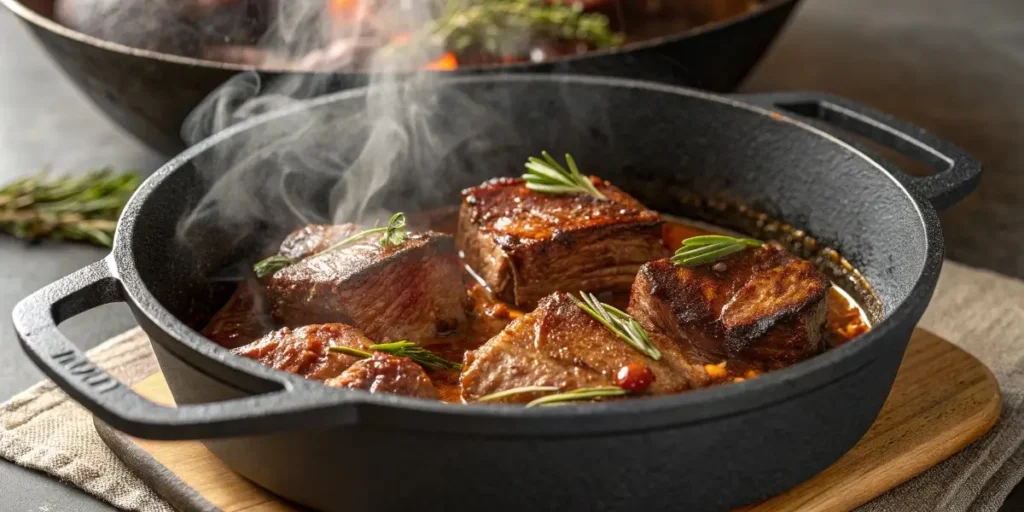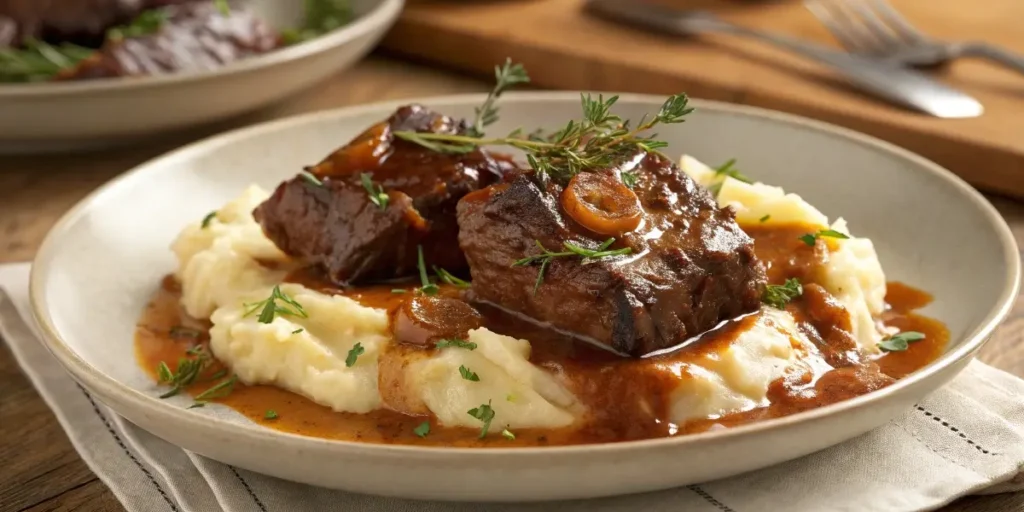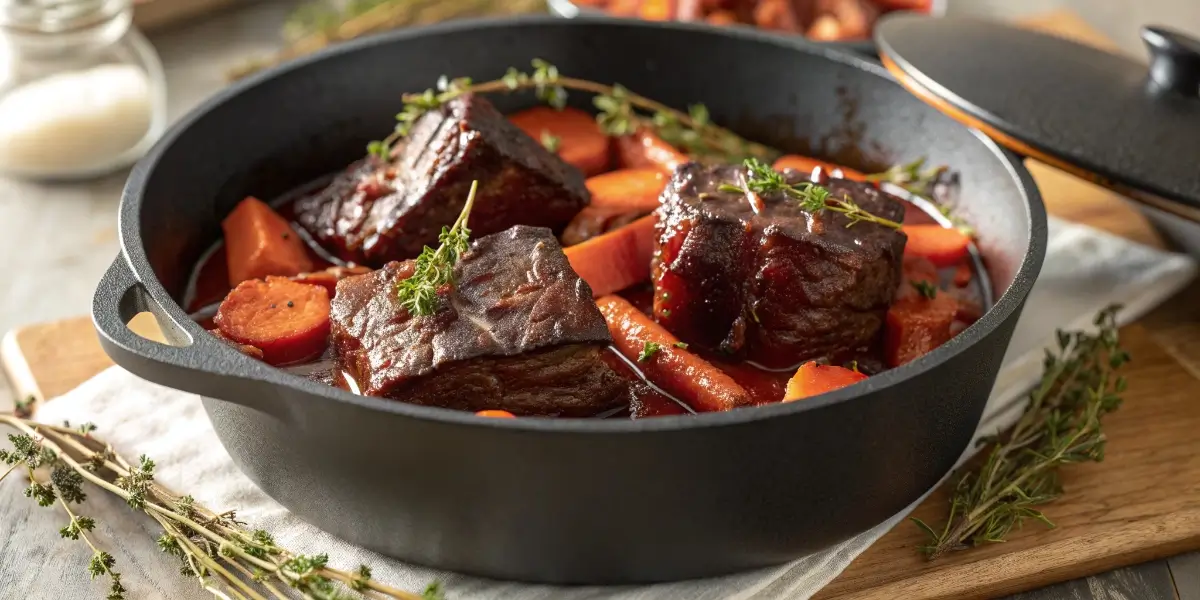Perfect Braised Boneless Short Ribs Recipe — Tender, Rich, and Full of Flavor
If you’re craving a hearty, comforting dish that melts in your mouth, this braised boneless short ribs recipe is just what you need. Slowly cooked until perfectly tender, these short ribs are infused with deep, savory flavor from wine, broth, and aromatics. Whether you’re planning a cozy family dinner or an impressive weekend meal, this recipe guarantees restaurant-quality results right from your kitchen. Learn more about flavorful beef dishes in our guide to delicious ground beef crock pot recipes.
Table of Contents
Understanding Braised Boneless Short Ribs
What Are Braised Boneless Short Ribs?
Braised boneless short ribs are rich cuts of beef that come from the chuck or plate section of the cow. Unlike grilled or roasted meats, they’re seared first for flavor, then cooked slowly in liquid at a low temperature. This process allows the tough connective tissues to break down, resulting in meat so tender it practically falls apart with a fork. The result? Deep, bold flavors and a silky sauce that coats every bite.
Why Braising Makes Short Ribs Irresistibly Tender
Braising is the secret behind the magic of short ribs. The slow, moist heat transforms tough cuts into melt-in-your-mouth perfection while locking in moisture and flavor. The combination of searing and slow cooking enhances the beef’s natural richness and allows every ingredient—from onions and garlic to herbs and broth—to mingle beautifully. Don’t miss our pot roast seasoning tips to elevate your next braised dish with the perfect flavor balance.
Choosing the Right Cut for Braised Short Ribs
What Cut of Meat Works Best for Braised Short Ribs
When making a braised boneless short ribs recipe, the cut you choose plays a huge role in the final flavor and texture. Boneless short ribs usually come from the chuck or shoulder, known for rich marbling and beefy taste. This fat content ensures juicy, tender results when slow-cooked. If you can’t find boneless short ribs, you can substitute with chuck roast slices cut into thick pieces—these hold up beautifully during braising and deliver that same hearty bite. For best results, choose USDA Choice or Prime grade beef for extra tenderness and depth of flavor.

Bone-In vs. Boneless: Which Should You Choose?
Bone-in short ribs tend to have slightly more flavor due to marrow release during cooking, while boneless short ribs offer convenience and easier serving. If you prefer a clean presentation or plan to use the meat in pasta or sandwiches, go boneless. For a classic dinner served with mashed potatoes or roasted vegetables, bone-in can’t be beaten. Either way, slow cooking is key—low and slow brings out the richness that defines this dish. Discover great ideas like our smothered chicken recipe for other slow-cooked favorites, or try our picanha steak guide for more beefy inspiration.
Essential Ingredients for the Best Braised Short Ribs Recipe
The Core Ingredients You Need
Creating the perfect braised boneless short ribs recipe starts with a few high-quality essentials. Begin with 3 to 4 pounds of boneless short ribs—well-marbled cuts work best for flavor and texture. You’ll also need a base of onions, carrots, celery, and garlic for that signature depth. For richness, use tomato paste and a touch of red wine to deglaze the pan. Add beef broth, fresh thyme, bay leaves, and a little Worcestershire sauce for complexity. Each ingredient builds on the next, turning a simple cut of beef into a dish bursting with bold, comforting flavor.
Best Liquids for Braising Short Ribs
The liquid you choose determines how flavorful your final sauce will be. A combination of red wine and beef broth is the classic pairing—it enhances the beef’s richness while balancing the natural fat. If you prefer a non-alcoholic version, use a mix of balsamic vinegar and extra broth for depth. For something lighter, dark beer or mushroom broth adds earthy undertones that complement slow-braised meat perfectly. Looking for inspiration? Try our garlic parmesan chicken pasta for another comforting meal made with a flavorful sauce base.
How to Braise Boneless Short Ribs Like a Chef
Step-by-Step Guide to Perfect Braising
To achieve restaurant-quality braised boneless short ribs, start by patting the meat dry with paper towels—this ensures a beautiful brown crust when searing. Heat oil in a Dutch oven, sear the ribs on all sides until deep golden, then remove and set aside. In the same pot, sauté onions, carrots, and garlic until fragrant. Stir in tomato paste, scraping up all the browned bits for added flavor. Deglaze with red wine or broth, then return the meat to the pot. Add enough liquid to cover two-thirds of the ribs, cover tightly, and cook low and slow at 325°F for about 2.5 to 3 hours. Once done, the ribs should be fork-tender with a rich, glossy sauce.

The 3-3-3 Rule for Ribs Explained
Many chefs follow the “3-3-3 rule” when perfecting their short ribs—it’s a simple way to balance searing, simmering, and resting. First, sear for 3 minutes per side to build flavor. Next, braise for about 3 hours at low heat to tenderize the meat completely. Finally, let the ribs rest for 30 minutes (roughly 3×10 minutes) before serving, allowing the juices to redistribute. This method ensures that each bite stays moist and flavorful. Don’t miss our king salmon recipe for another slow-cooked favorite packed with rich, savory notes.
Cooking Methods and Timings
How Long Do Boneless Short Ribs Take to Cook?
Cooking time is crucial for achieving fall-apart tender braised boneless short ribs. Typically, oven braising takes about 2½ to 3 hours at 325°F. You’ll know they’re ready when the meat easily pulls apart with a fork. If using a slow cooker, plan for 7 to 8 hours on low or 4 to 5 hours on high. The Instant Pot shortens the process dramatically—pressure cook on high for about 45 minutes, followed by a natural release. Regardless of the method, patience pays off. The longer the ribs simmer gently, the deeper the flavor and the softer the texture become.
Oven vs. Slow Cooker vs. Instant Pot — Which Method Wins?
Each cooking method brings its own charm. Oven-braised short ribs develop a rich, caramelized sauce that’s hard to beat. The slow cooker is great for hands-off convenience—just set it and forget it. Meanwhile, the Instant Pot shines when you need comfort food in under an hour. If you want that classic, deep flavor, the oven remains unbeatable. But for busy nights, the slow cooker wins for convenience and flavor consistency. Check out our delicious ground beef crock pot recipes to explore more set-and-forget comfort meals that turn out just as satisfying.
Flavor Enhancements and Serving Ideas
Best Herbs, Spices, and Seasonings
What makes a braised boneless short ribs recipe truly unforgettable is the flavor layering. Start with simple aromatics—garlic, onions, and carrots. Add bay leaves, fresh thyme, and rosemary for an earthy, savory foundation. For deeper complexity, use smoked paprika, black pepper, and a touch of soy sauce or balsamic vinegar. These ingredients amplify the beef’s richness without overpowering it. Finish with a sprinkle of sea salt or a splash of red wine reduction before serving to highlight the tender, juicy meat. For another rich, savory dinner idea, check out our smothered chicken recipe.

Side Dishes That Pair Perfectly with Braised Short Ribs
The best companions to braised boneless short ribs are sides that soak up that luscious sauce. Creamy mashed potatoes, buttery polenta, or garlic-infused rice balance the ribs’ bold flavors beautifully. For a lighter touch, serve them with roasted vegetables, sautéed green beans, or a fresh herb salad. If you prefer something indulgent, cheesy baked macaroni or truffle mashed potatoes turn it into an elegant feast. Looking for inspiration? Try our garlic parmesan chicken pasta for another perfect comfort-food pairing idea that complements this dish’s richness.
Common Mistakes to Avoid
Overcooking or Undercooking the Ribs
Even though braised boneless short ribs are forgiving, timing is everything. Overcooking can cause the meat to dry out and the sauce to turn greasy, while undercooking leaves it chewy and tough. Always check for doneness by testing a piece with a fork—it should slide in easily. If the sauce reduces too quickly, add a bit more broth or wine to keep it silky and moist. Keeping a consistent low temperature is key to ensuring perfectly tender ribs every time. For more slow-cooked tips, don’t miss our guide on delicious ground beef crock pot recipes.
Choosing the Wrong Liquid for Braising
Not all liquids are created equal for braising. Avoid using plain water—it dilutes flavor instead of enhancing it. The ideal liquid has depth and richness, such as red wine, beef broth, or dark ale. These infuse the meat with character and balance its fattiness. If you’re sensitive to wine, use a mix of balsamic vinegar and broth for a similar effect. Always deglaze the pan after searing; those browned bits at the bottom are liquid gold for your sauce. Discover great ideas like our pot roast seasoning guide to build flavor foundations for any braised dish.
Conclusion — Mastering the Art of Braised Boneless Short Ribs
Key Takeaways for a Flavorful, Fall-Apart Result
Making the perfect braised boneless short ribs recipe is all about patience and layering flavors. Start by choosing the right cut, sear it for depth, then let it cook low and slow until it’s melt-in-your-mouth tender. Use rich liquids like red wine or beef broth to create a sauce that’s bold yet balanced. Don’t rush the process—every minute of slow braising develops complexity and texture. Whether served with mashed potatoes, rice, or creamy polenta, these short ribs deliver a truly comforting meal that’s worth every bite. For more cozy dinner ideas, check out our garlic parmesan chicken pasta.
Try This Recipe for a Comforting Family Dinner
Once you’ve mastered braising, this dish will quickly become a household favorite. The tender beef, savory sauce, and aromatic vegetables make it a timeless comfort food. Serve it for Sunday dinners, holidays, or whenever you crave something hearty and soul-warming. If you loved this recipe, you might also enjoy our delicious ground beef crock pot recipes for more easy, flavor-packed meals that bring everyone to the table.
FAQs
Can I braise boneless short ribs?
Yes, absolutely! Boneless short ribs are perfect for braising because they’re meaty, well-marbled, and become incredibly tender when cooked slowly. The key is to sear them first to develop a rich crust, then let them simmer gently in a flavorful liquid like red wine or beef broth. This slow, moist cooking process locks in flavor and ensures the beef melts in your mouth.
What cut of meat do you use for braised short ribs?
The best cut for a braised boneless short ribs recipe comes from the chuck or shoulder area of the cow. These cuts are rich in connective tissue and marbling, which break down beautifully during long, slow cooking. This gives the dish its signature tenderness and full-bodied flavor.
What is the best cooking method for short ribs?
Braising is hands-down the best way to cook short ribs. Searing the meat first develops flavor, and then slow cooking it in liquid (like wine, broth, or beer) makes the beef fall-apart tender. The Dutch oven and slow cooker are both excellent choices for consistent, flavorful results.
How long do boneless short ribs take to cook?
Typically, boneless short ribs take about 2½ to 3 hours in the oven at 325°F. In a slow cooker, plan for 7–8 hours on low or 4–5 on high. The Instant Pot can do the job in about 45 minutes under pressure. The key is slow, gentle heat — that’s what makes the meat fork-tender.
What is the 3-3-3 rule for ribs?
The 3-3-3 rule is a simple guideline for perfect short ribs: sear each side for 3 minutes, braise for about 3 hours, then rest for 30 minutes before serving. This ensures a flavorful crust, a juicy interior, and perfectly balanced texture.
What liquid is best for braising short ribs?
A blend of red wine and beef broth is the classic combination — the wine adds depth and acidity, while the broth enhances the beef’s richness. For a non-alcoholic version, try using balsamic vinegar or grape juice mixed with broth. Each gives the sauce a deep, savory flavor that complements the tender meat beautifully.

